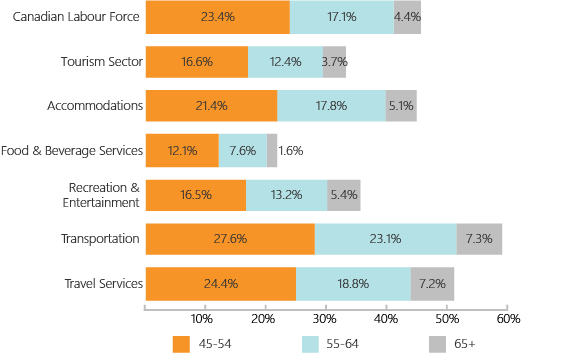Released today, the latest demographic profile of tourism workers unveils the most recent census data on mature workers employed in tourism.
The profile looks at workers aged 45 and up, breaking key employment information into three groups: ages 45 to 54, 55 to 64, and 65 and up. While these age brackets have generally been less represented in tourism jobs, an aging population and a decline in the number of young workers (a group heavily relied on for tourism employees) means employers are seeking ways to attract and retain older workers.
While the tourism sector had a lower share (32.9%) of workers over 45 than the economy as a whole (44.9%), a look at each industry group shows that transportation (58.0%) and travel services (50.4%) actually have higher percentages.
When looking specifically at workers over 65, four out of the five industry groups employ a higher share of this age bracket than the overall Canadian labour force:

There was also regional variation. Nunavut had the smallest percentage of tourism workers over the age of 45, at 27.4%, followed by Alberta, at 28.3%. Nova Scotia had the largest percentage of mature tourism workers, at 35.4%, an increase from 33.1% in 2011.
Meanwhile, the share of tourism workers over the age of 65 has risen in all provinces and territories since 2011. Nova Scotia saw the greatest increase, where this age bracket went from making up 2.8% of tourism workers to 4.1%. Overall, the share of workers over the age of 65 was highest in the Northwest Territories (5.0%) and Yukon (6.1%).
Over the next several years, the number of people aged 55 to 64 will increase slightly, while the number of people over the age of 65 will increase rapidly. While 65 is traditionally considered the age of retirement, retirees are increasingly seeking seasonal or part-time work, whether to keep connected to the community, to find new ways of sharing their skills and knowledge, or to supplement retirement income. This matches perfectly with the needs of many tourism operators.
While Canada is seeing record numbers of international visitors, keeping pace with the growth has been difficult due to labour shortages. To fill the gap, employers are expanding attraction efforts to include mature workers, such as:
- Advertising the flexible schedule of many tourism opportunities
- Connecting with bridging programs for recent retirees or career changers
- Showcasing the mentoring opportunities available
- Providing accommodating workplaces for health conditions that become more prevalent with age
Click here to download the Demographic Profile of Mature Tourism Workers.
Subscribe to Tourism HR Insider for future demographic profile releases.

